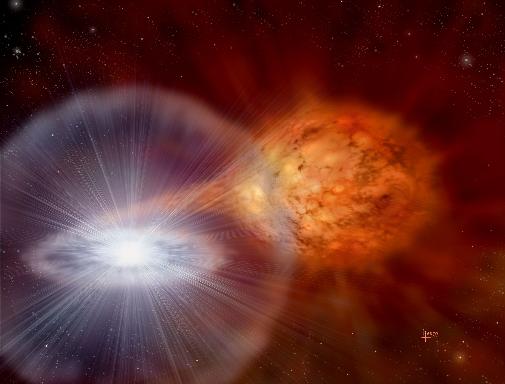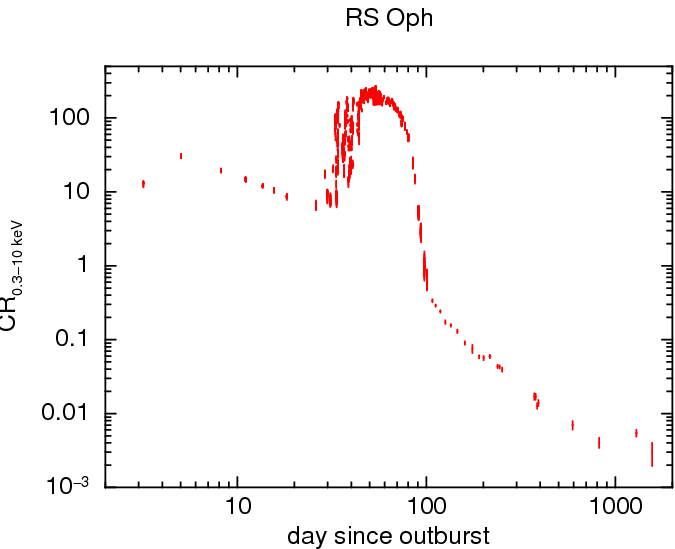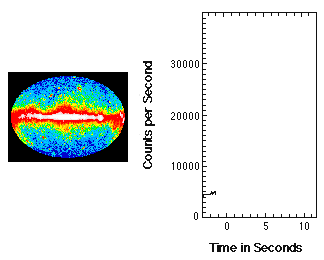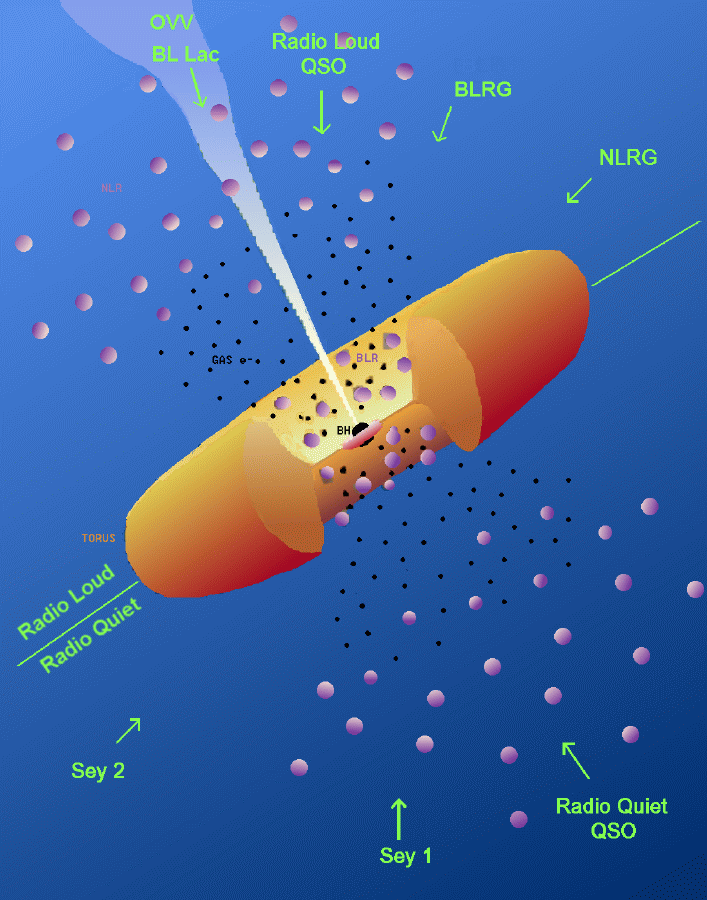Jump to Gamma-Ray Bursts or AGN
Novae

Credit: David Hardy/PPARC
The image above shows an artist's impression of the explosion of RS Ophiuchi. There is also a movie created by Dr Andrew Beardmore (University of Leicester). depicting a nova outburst similar to the RS Ophiuchi system, where a white dwarf (centre), which has steadily been accreting material from a red giant companion, undergoes a thermonuclear explosion on its surface.
Novae are cataclysmically explosive transients, formed by the nuclear
fusion of hydrogen on the surface of a white dwarf (WD). They occur in
interacting binary systems, with a secondary star accreting onto the
WD until the point at which there is sufficient matter to trigger a
thermonuclear runaway.
Most novae are only seen to go into outburst once (the name "nova" comes from the Latin for "new"); however, there is a small but significant subset known as "recurrent novae", which are seen to go into outburst more than once within a human lifetime. RS Oph, envisioned in the image above, is once such system, erupting every 20 years or so. The last outburst was in February 2006 and was followed in great detail by the Swift satellite. The light-curve is plotted below, demonstrating how the X-ray emission varied between ~2 days and more than 4 years after the outburst.

My main area of nova research focuses on the so-called Supersoft Source (SSS) phase. Following the thermonuclear explsoion on the WD surface,
an envelope of material is expelled and obscures the X-ray emission occurring on the surface of the WD.
As the
ejected material expands further, however, it eventually becomes optically thin and the surface nuclear burning becomes visible,
with emission peaking in the soft X-ray band; this is the SSS phase.
During the onset of this phase, some (recurrent) novae show a large amount of variability in their X-ray emission (see days 30 - 45 in the plot above). This was discovered through the intensive Swift monitoring campaigns and the processes involved are still being investigated.

|
This animation shows a GRB detected by BATSE (the Burst And Transient Source Experiment) which was on-board CGRO (the Compton Gamma-Ray Observatory).
|
GRBs were first discovered accidentally in the late 1960s by the Vela
satellites, which were actually being used to ensure no nuclear
devices were being tested in the atmosphere. However, instead
of providing proof of illegal testing, the gamma-ray events detected
were found to be cosmological in origin (i.e., from outside the
atmosphere, well away from the Earth itself).
GRBs are the most explosive events in the Universe since the Big Bang and outshine the rest of the gamma-ray sky for the time they are visible.
It is found that there are 2
"populations", with some bursts lasting only milliseconds, while
others have a duration of a few hundred to a few thousand seconds. (GRB 090417B holds the record, with a duration of at least ~2130 s.)
A plot of number of
bursts against duration shows the "dividing line" between the groups
is at about 2 seconds, with peaks in the distribution occuring at ~0.3
and 30 seconds.
Long (> 2 s) GRBs are thought to be formed when a massive star reaches the end of its live, while short (< 2 s) GRBs may be formed through the merger of two neutron stars. In both cases, a black hole is formed and huge amounts of energy emitted.
The launch of Swift on 20th November 2004 has revolutionised GRB research. Swift is a multi-wavelength observatory, designed to study transient objects, specifically GRBs. When the BAT (Burst Alert Telescope) triggers on an increase in gamma-rays, Swift will automatically slew to point its narrow field instruments - the X-ray and UV/Optical Telescopes (XRT and UVOT, respectively) - towards the burst, typically within 60-100 s of the trigger time. This leads to the rapid follow-up of the GRB afterglows - i.e. the emission which occurs after the prompt gamma-rays have died away.
A Swift-detected burst, GRB 090429B, may be the most distant object ever discovered, at a redshift of ~9.4 (meaning it went off only 520 million years after the Big Bang)!
See this Introduction to GRBs page on the UK Swift website for more details about GRBs in general.
I have been a member of the Swift team since August 2004, working at the UK Swift Science Data Centre.
My PhD research was performed in the field of Active Galactic Nuclei (AGN), specifically X-ray observations of both the lower-luminosity Seyfert Galaxies and the higher-luminosity Quasi-Stellar Objects (QSOs; sometimes also referred to as quasars).
It is generally thought that AGN are powered by matter from an accretion disc fuelling a central, supermassive (~106-109 Msun) black hole.
All galaxies may contain central, massive black holes, but only those which are adequately fuelled are seen as active. AGN are the brightest continuously emitting objects in the Universe (Gamma Ray Bursts are much brighter, but for only a short period of time) and can reach bolometric luminosities (that is, summed over all wavelengths) of 1040-1048 erg s-1. (An erg is the unit of energy most astronomers use; it is equal to 10-7 J.) The luminosity emitted by the nucleus can be as bright (in Seyfert galaxies) or brighter (in the case of QSOs) than all the stars of the host galaxy (~1011 Lsun) put together. Because of this, the active galaxy can appear as a point source (like a single star) to a distant observer; this is what led to the term Quasi-Stellar objects.
Although we are pretty certain that AGN have central supermassive black holes, it is not yet possible to image them directly. This will (hopefully!) be resolved by the advent of X-ray interferometry. Interferometry means that there are lots of telescopes, all linked together, observing the same object. This allows much finer resolution than can be obtained by a single instrument. Interferometry is already used in different wavebands; for example, in the UK there is a radio interferometer called MERLIN (Multi-Element Radio-Linked Interferometer Network). Thus far, the design of X-ray interferometers has been hampered by the failure to build suitable diffraction-limited optics. However, such optics are now becoming feasible, so X-ray interferometry should be on the way!
X-rays are emitted by high-energy processes, making them a very useful tool for astrophysics. In the case of AGN, the X-rays are thought to come from either the inner regions of the accretion disc, or a hot corona of electrons above the disc. The effects of strong gravity reveal themselves in X-ray spectra, allowing astronomers to analyse the environments around supermassive black holes.

This figure (borrowed from the BeppoSAX calendar)
shows a schematic diagram of an AGN.
The label of AGN covers many
different types of objects (radio-loud and radio-quiet, narrow-line
and broad-line) and it is thought that some of these differences are
simply due to the angle at which the AGN is observed. | ![[The University of Leicester]](UoL-Logo-Inverse-white.png)

![[The University of Leicester]](UoL-Logo-Inverse-white.png)
